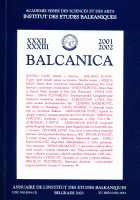Tragom ranih keltskih uticaja na prostoru Timočke krajine
On Tracing Early Celtic Influences in Timocka Krajina
Author(s): Miodrag Sladić Subject(s): Archaeology
Published by: Balkanološki institut - Srpska akademija nauka i umetnosti
Keywords: Timocka Krajina; bronze fibula; hybrid animal;
Summary/Abstract: During 1996, in the systematic excavations carried out on Banjska Stena site, upstream from Gamzigradska Banja, a bronze crossbow zoomorphic fibula was found. It belongs to the type of Early La Tene fibulae having on the upturned foot a knob styled in the form of a hybrid animal, and modeled in the shape of a fish caught in the net, or maybe a fish with a harness. According to research so far, it is thought that the idea for their creation was inspired by the images of dragons represented on the scabbards of Early La Tene swords, as well as on pottery vessels of the type of tulip shaped tall goblets. In accordance with the concentration of these findings, and bearing in mind their Celtic origin, they can be considered to have originated from south-eastern Pannonia, in the present-day Hungary (Szent Andrea, Liter, Sopron-Becsidombrol), and western Rumania (Pecica). Later on, the distribution of such fibulae spread to Posavina (Donja Dolina), as well as to Serbian Podunavlje (the Danube valley) – Viminacium. However, although the finding from Banjska Stena is the most eastern one (Timočka Krajina) from the centre of their origin, it can be given absolute chronological primacy within this type of fibulae, due to great similarities to the fibulae originating in the Celtic culture central area (Val-de-Travers). The fibula from Banjska Stena should be dated into the middle of 4th century, or at the very beginning of the creating of this type of fibulae, whereas others may generally be dated in the second half of 4th century AD.
Journal: BALCANICA
- Issue Year: 2001
- Issue No: 32+33
- Page Range: 37-49
- Page Count: 12
- Language: Serbian

